#and i’ll probably also mention the fun theory that all caves/buildings are the same
Explore tagged Tumblr posts
Text
hello friends i wanted to ask for help from those with a better memory for lore/details from the games than i have. a friend of mine is doing a presentation party soon, and i want to do mine on da2 - why my favorite game kind of sucks and how i’d fix it lmao i’ve got a lot of ideas and have been replaying it to find extra details, but my memory isn’t great and i know there’s a lot of great meta posts about it on here, so i wanted to give y’all a chance to chime in! what are some things you think i should include? what are your favorite or least favorite aspects of the game? what parts are really cool and what parts do you hate? specific examples of scenes/quests/dialogue would help - also, if you know of any posts or anything else that have this type of info, send them my way! i love da2 and i’m very excited to talk about the game that it is and also the game that it could have been, so i want to be sure i have enough for it to make sense!
#da2#dragon age#dragon age 2#da#she speaks#ty to anyone who sends me anything!!#my memory/cognition in general is Garbage these days lol#also i apologize for being so so inactive on here for so long#da4 news has driven me back to the brink i fear#so far i plan to focus a lot on the anders/fenris rivalry and their lack of late-game development#plus the weirdness of having to fight both the first enchanter and meredith at the end#and i’ll probably also mention the fun theory that all caves/buildings are the same#and other little details are weird/inconsistent#bc the whole thing is just varric telling a story#i will also be starting with an acknowledgment that considering how rushed it was the game is FANTASTIC
19 notes
·
View notes
Text
Smoke and Mirrors Pt. 2
Summary: The Bat Family prepares to help you finish solve the case you’ve been investigating. After a bitter six months separated from Jason Todd, your reunion might be a bit messier than expected. Part 2 of a series.
Also, for everyone out there about to take/taking finals, best of luck to all of you! You’ll all do amazing things! (:
Part 1
Word Count: 1242
Warnings: Mention of human trafficking.
You wake up to the patter of typing fingers. A disruption. What you make out to be a slurp. The typing gets faster, aggressive but restrained. Tim must be looking at the details of your case. You prefer to work your cases out the old-fashioned way, on paper, in notebooks, so there isn’t much to see in the notes on your computer, which Tim has already hacked into. Once he sees what’s there, he looks at the footage near the park. He begins finding the cars you’ve identified as belonging to the ring. He’s preparing the team for what he thinks you’ll push them to do.
The limited rest you got was full of forgettable fits. Not quite awake, you’re sure of one thing: the Bats will get you into wherever the metas are being held, and get them out before they can be shipped into an unimaginable fate. The case ends tonight. Sitting up, you can feel the stiches in your arm shift. Alfred did a good job, and you can feel the painkillers coursing through your veins. Artificial strength. But you’re used to that.
“Y/N’s up!” You hear Tim call, along with disarrayed footsteps coming clearer into focus.
You swear, your last intention is to make eye contact with Jason. But his eyes are the first thing you see, and you’re stubborn enough to not look away. You can tell he looks angry, but mostly worried. Back when you were together, you could have expected him to give a lengthy lecture at this moment, which you would find immensely hypocritical. He had trained you, after all.
Jason remembered those sweet winter nights in the first few months, after he had revealed himself to you. Under the helmet, he was a warrior with hundreds hours of training that rivaled some of the greatest fighters of the world. When Gotham was cold outside, he would bring you down here, and you would warm your limbs by sparring endlessly. At first, it was easy to tell he was taking it easy on you. When you started to notice he was getting sloppy, you got faster, sometimes even dictating the pace of the fight. After months of sweat, close moments on the mat, and endless practice, you could hold your own. And he knew it.
Hell, he’d even taught you to shoot. Before Jason, you refused to touch a gun, thinking you would probably shoot yourself in the foot. But with his callused hands on your hips, lining up your sight of vision, his breath on your neck, demolishing the target became half the fun. You were a decent shot, and went to the range sometimes to clear your mind of a case and get a better start on a lead. You had learned to steady yourself after the kickback of the pistol without a man’s perfect form behind you. Sometimes you could smell him, filling you with inescapable hope and dread, but eventually decided it was the gunpowder playing mind games with you.
You knew it was reckless to walk on the scene in the park. But you also legitimately believed you had no choice. Your conviction started to wane as you stared into Jason’s hard eyes, so you looked immediately at Dick and explained what you knew. Schedules. Patterns. Locations. Theories. Everything out on the table. It felt good to unload all you had on a team. You had to admit that you had started to get a bit obsessive about this case. Slowing dragging yourself out of a hole you had dug too deep. You could still feel Jason’s eyes pouring into you, almost looking for an opportunity to strangle you during your speech.
It took a few hours before the team was able to come up with a concrete plan. Tim used his connections to track the traffickers down to a warehouse owned by one of Gotham’s most notorious mobsters, and lined the blueprints of the old factory across the screens of the Cave.
“There’s data being sent to a few locations out of the warehouse. It’s encrypted, but the code looks like it was done pretty lazily,” Tim said, and you can already see the way the dots are lining up in his head. He’ll be done organizing the information in minutes. “Looks like most of it is being sent to an office building in the Financial District.”
So, two primary locations. The information on Tim’s screens is overwhelming: data from medical experiments, customers, travel dates. It’s hard to believe that such a small number of meta-humans, (you’ve estimated the group operates with ten at a time) can garner so much information.
Bruce is all business. He can feel the same sense of doom over the abduction of a new metahuman and the group’s new sense of aggression. Already donning the cowl, he splits the team into two as soon as he gets a refresher on the new information you’ve brought to the team. Dick, Tim and Damian will accompany Bruce to the warehouse to break the metas out. When he says that Cass will provide you and Jason cover for entering the office building, you nearly jump of your skin, ready to protest, but Jason beats you too it.
“Bruce, that’s pretty obviously a bad idea. There’s no way in hell I’m walking in with her. She’s unstable.” That’s petty. Even for him. He knows how much that word drives you crazy.
As much as it pisses you off to think that Jason now thinks you can’t handle your own, the urge to prove him wrong has a stronger hold on you.
“I can handle the office building,” you say, with more confidence than you probably should, “with or without Jason.”
That shuts him up. You can practically feel the heat coming off of his skin. You’ve also made the assumption that Bruce wants you to continue collecting information by going straight to the source, and you’re the expert here. Everyone makes their moves to prepare for the ambush, leaving you with Jason.
“I’ll be on my bike in five. If you’re late, I’m leaving without you.”
“Fine. I’ll be there.”
As he walks away, you can see the tension in Jason’s neck. He’s fuming, and the extra anxiety you’ve given him might make him a bit more reckless. You push each other’s buttons nowadays. A year ago, you would have placed a soothing hand across his chest to ease those fears that consumed him. Now, you found yourself a scapegoat for his rage. Then again, you weren’t going to forgive him for what he had done anytime soon.
As Bruce makes the final preparations to lead the rest of the team across the other side of Gotham, you check the condition of your pistol and notice a still figure.
Preoccupied, Red Robin had yet to move. You can see Tim scowl at a large collection of information being sent to a location in England. More than would be necessary for a single buyer. Or even a plethora of buyers. Thousands of files, labeled with names you had never seen before. When he looked at you, you could tell exactly what he was thinking: this operation was bigger than you had thought. With international implications. If there was any night to understand the magnitude of the case, it was in the ambush tonight. And you were prepared to use any amount of force necessary to get that information. Even with the heaviness of Jason’s presence by your side.
#jason todd#jason todd imagine#jason todd imagines#reader x jason todd#red hood#red hood imagine#reader x red hood#red hood x reader#jason todd x reader#dc#dc comics#dc imagine#dc comics imagine#tim drake#time drake imagine#batman#batman imagine#dick grayson#dick grayson imagine#dick grayson x reader#robin#robin imagine#bat family#bat family x reader#bat family imagine#batfam#batfam x reader#imagine#comics#comic imagine
84 notes
·
View notes
Text
Friday, September 29th 2017
POMPEII, AND THE BAY OF NAPLES, IS A BEAUTIFUL PLACE.
Before I go into more detail, I just wanted to mention something. For most students at Temple Rome, they have chosen to study abroad here rather than elsewhere simply because our school has a campus here. It’s a study abroad opportunity, true, and they enjoy living here because it’s different from the United States, because they get to experience a new culture, learn a new language, and it’s in Europe, which means quick and cheap flights to anywhere within the EU. I don’t disagree with any of that, and I think they’re all perfectly, excellently valid reasons for choosing to stay here for a semester or a year.
That’s not why I’m here, though. I’m in Rome because it’s Rome. I’m not jetting off to Munich or Paris every other weekend because this isn’t just an easy access point for me. I’ve been studying Latin for six years now. I’m getting a degree in Classics. I never grew out of my little kid obsession with Greek and Roman mythology, and now I’m majoring in it. I was seven when I first picked up a book on mythology and I haven’t really put it down since. I’m in Rome. I get to walk along the Tiber each morning and see the Colosseum in the distance and that is ridiculous to me, even now, after almost two months. I’ve read letters and poems and speeches about the streets that I’m walking down to get to school every day and that’s insane.
Rome is a modern city, though, and it’s impossible to forget it, even with my imagination. So you can imagine how I felt wandering through the ruins of Pompeii.
I’ve been to Pompeii once before, on a day trip for one of my roommate’s birthdays, and we did a rather stumbling self-guided tour which, while very fun, was hardly informative. This particular trip, however, was an excursion associated with my Roman History course, lead by a professor who lives and breathes classical history, and who promised us before we left that it would be a death march through the ruins and we would get more information than we knew what to do with over the next three days. I was, as you might expect, very excited.
We took a big coach bus down on Friday, boarding at 7 in the morning exactly (I am not afraid to leave late students behind!! -Professor, on three different occasions when reminding us that when he says we leave at 7 he means we leave at 7). We were immediately given a forty some page packet of maps, floor plans, and letters of Pliny, and then left to fall, one and all, to sleep during the first couple hour leg of the journey.
We did not end up in Pompeii during the first day. Instead, we went to a beautiful little town called Terracina, in the bay of Naples, to visit the temple complex of Iuppiter Anxur, a gorgeous building that overlooks Terracina and the bay from a cliff, with foundations dating back to long before the Romans were out conquering the whole of Southern Italy (the Roman colony of Terracina, if you were curious, was founded in 329 BCE), though the current iteration was built primarily in the first century BCE, at the time of the second triumvirate, as part of a veteran colony. The temple was probably dedicated to Jupiter (hence the name), though there are theories about it really being a Venus territory.
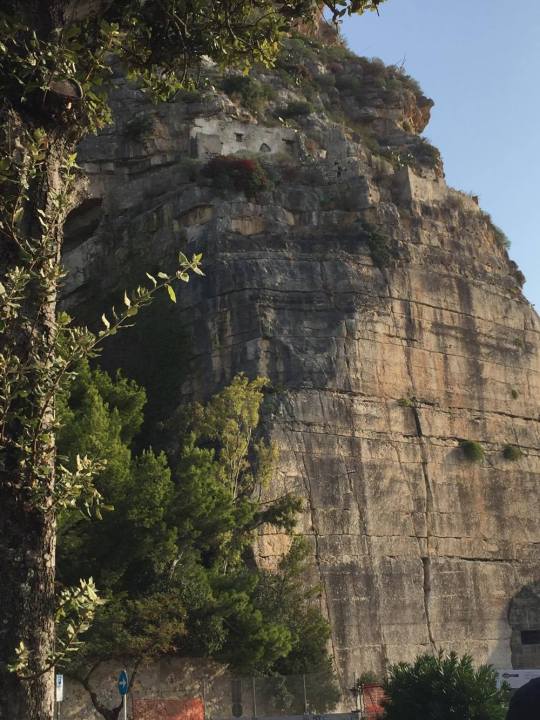
At the base of the cliff on which the temple sits, notable because it’s not actually a natural cliff. About two thousand years ago, give or take a century or two, the Romans decided that going around the mountain took too long, so they just…. moved the mountain. Carved it flat and made a passageway. If you look closely at the cliff you can actually see Roman numerals that were carved into the rock to indicate how much was cut away at that point. At the highest point, 120 ft of stone was removed.
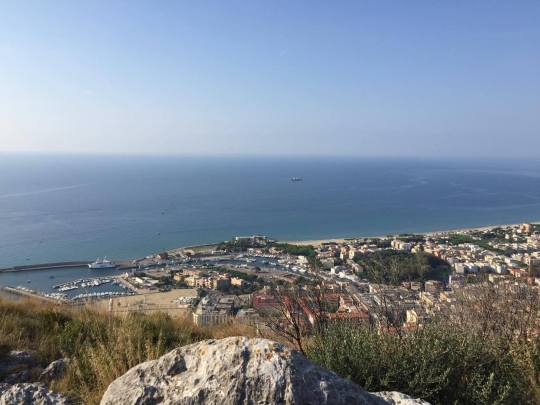
Terracina and the bay of Naples from the temple, because it was stunningly beautiful.
There is no photograph of the actual temple, I’m afraid, because there was no way to get a good picture from the base of the cliff, and no way to capture everything when we were wandering around inside. Google Terracina Iuppiter Anxur if you’re curious.
Following Terracina, we headed off to the Villa of Tiberius.
CRASH COURSE IN VILLAS: There are two kinds of villas. You might think that there are three kinds of villas. You would be wrong. The two kinds of villas are called villa urbana and villa rustica. Neither of them exist within the boundaries of any ancient city, because villas are, by definition, country estates. If it’s a house in the country, it’s a villa. If it’s a house in the city, it’s a domus at best. The villa rustica is essentially a farmhouse. Rustic, you might say. Like something one might expect to exist in the countryside. The villa urbana is like if you were a very rich person and could pack up everything that you liked about being in a booming metropolis of a city like Rome, and then stuck it in a house in the countryside so that you could feel free from city woes. There is an absolutely hysterical genre of poetry written by Roman poets who think that they should be able to tell you how to live in the countryside and ‘rough it’ because they happen to have access to a house that is, in the most basic sense, in the country. Lots of stuff about how to farm written by dudes who have, once, glanced out of their gilded window frames to observe a slave in the field across the way. Go read the Georgics (Virgil, pre-Aeneid. Don’t get me wrong, fantastic political commentary in that poem, but in no way is it actually about “agricultural things,” even if that is the Greek translation of the word georgic.
Villa culture was, essentially, about flaunting wealth, and reveling in your own status as a highly educated member of the elite. You built the houses to have massive libraries and statuary and a view of the ocean, so that you could roll around in your own cultural and intellectual heritage in front of the fishes, and generally prove that you were better than everyone else.
Anyway, the Villa of Tiberius. Tiberius was emperor after Augustus, and got the entirely unenviable task of trying to convince everybody that emperors were a good idea (Augustus never technically declared himself emperor, you know?) and also trying to sort out the mess that happens when there are no rules because one single genius invented the entire government structure and ran it by himself for forty five years and then died without telling anyone how he did it all. I do not begrudge him his gorgeous villa, if only because he deserved a place to get some R&R after years spent trying to drag a reinvented governmental system from the hands of a dead man.
The coolest part of the villa (both figuratively and literally, actually) was the natural cave in the cliff wall that the villa was built next to. The base of the villa opened onto the ocean (you can not buy beach front property this good today, my friend), but the entire left side extended into the cave, and incorporated a gorgeous series of tide pools, both natural and manmade. This cave was the crowning jewel of Tiberius’s villa, and included several incredible sculptures that now live in the museum next to the villa’s ruins.
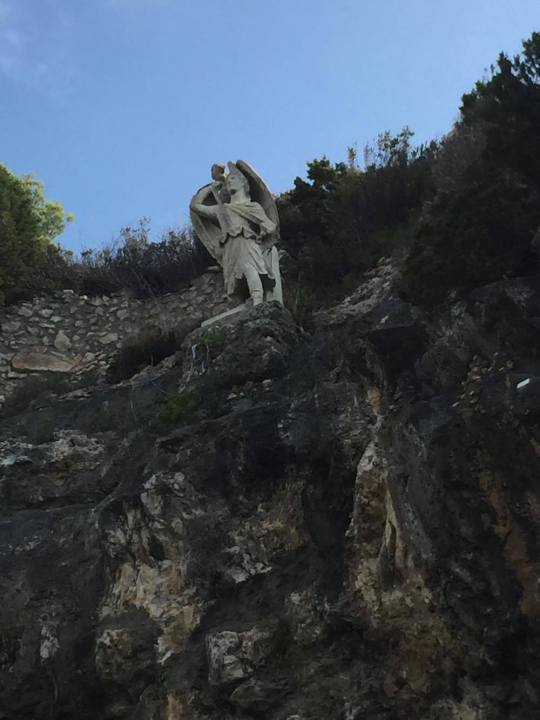
Statue of Ganymede, above the cave’s entrance. Looks like he’s got wings, but he doesn’t, actually, this is a statue that depicts the precise moment that Zeus, having looked down across the mortal world and seen Ganymede and thought Wow Pretty, sent an eagle to abduct him. For those of you who don’t know the myth, Ganymede is literally so attractive that Zeus makes him a god on Olympus. Just for being pretty. He’s Zeus’s cupbearer. If you thought people were joking about how very startlingly gay Ancient Greece was, you would be very wrong.
To be clear, there is nothing heterosexual about this story. At all. Zeus did not make Ganymede a god because he was lonely and wanted a good buddy to josh around with. Just. To be abundantly clear. Very very homosexual feelings all around, here. I say this because I once had someone tell me, to my face, that there was no way ancient Greek gods were actually gay. My dude, you have no idea.
(I mean, more accurately speaking Zeus is just very, very pansexual (or bisexual, depending on your preference), but this particular story is just super gay.)
Also, for those of you clever cookies who noticed that I’m not using the Roman name, good for you. The Ganymede myth does exist in Rome, he’s called Catamitus and was abducted by Jupiter, but this sculpture is pretty definitely Ganymede, because the theme for all of the sculptures in the cave was hellenism (or How Greek Can You Be: Roman Edition), but I’ll get to that later.
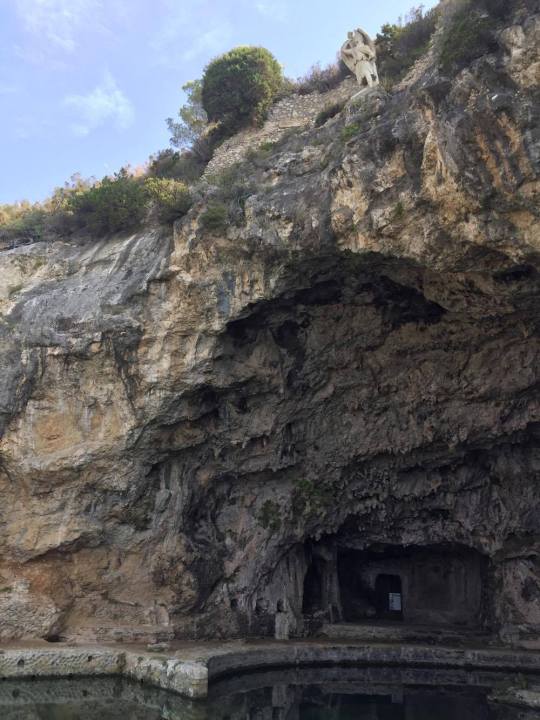
More cave! You can see the Ganymede sculpture all the way up at the tippy top. It’s a recreation, also, the sculpture is, the original is in the museum to preserve it. Most of the floor of the cave is taken up by a tidal pool, too, and you can see all the way in the back a carved out portion, and what looks like a door, and a glowing white square next to the door. For size reference of just how large (I hesitate to call it gigantic, only because I know there are caves that are much, much larger, but it was big to me, okay?) the cave is, I am about as tall as that glowing white square thing in that cut out room. Yes, I’m bitter about that. Moving on.
Another angle of that same cut out room, now inside the cave. You see what I mean about the floor, yeah?
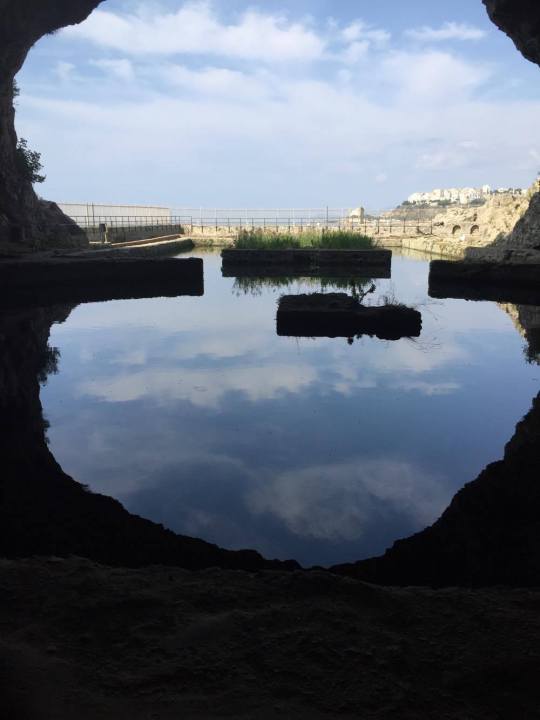
From the back of the cave. There was a large space behind me, of course, and there were those cut out rooms, but most of the cave was taken up by the pool. The theory is that there would have been a bedchamber area and a dining area in these cut out spaces, so that when the weather was too warm Tiberius could retreat to his cave house and live comfortably.
As you can see in the background, that whole area on the left where there doesn’t appear to be any sign of human habitation is the ocean. Honestly, if this were my villa, I would probably never leave. Screw running Rome, I want to sit in my cave beach house and read from my enormous library and have my servants bring me whatever I want. Sounds like a good life.

Now we get to the museum, and an artistic rendering of the cave statuary as it probably stood. That beautiful still glassy pool wouldn’t have been empty, not in an emperor’s house.

You’ve already gotten the spiel about letter E, Ganymede, so let’s move on to C, all the way in the back there (where I was standing to take that cave mouth photograph, actually, though that means almost nothing to you).

A recreation, of course, we don’t have this entire thing, but we have enough fragments and enough literary sources describing it to thing that this is pretty close to the original. This is, in all his alcoholic glory, Polyphemus, the cyclops from the Odyssey, who captured Odysseus and his men in his cave to eat them. Odysseus disagreed with that plan of action, for fairly obvious reasons, and thus got Polyphemus drunk, stabbed out his only eye with a burning stake, and then hitched a ride on the undersides of Polyphemus’s sheep (poor guy was a shepherd) in order to get out of the cave without being noticed (Polyphemus was blind, see, not dumb, so he felt the backs of his sheep to make sure that none of his captives rode out on them. He didn’t think to check the underbelly of the sheep because who rides on an underbelly? Nobody, that’s who). As one does. He also told Polyphemus, as he left, that his name was Nobody, which is why none of the other cyclops came to the rescue when Polyphemus shouted for help, because Nobody was attacking him.
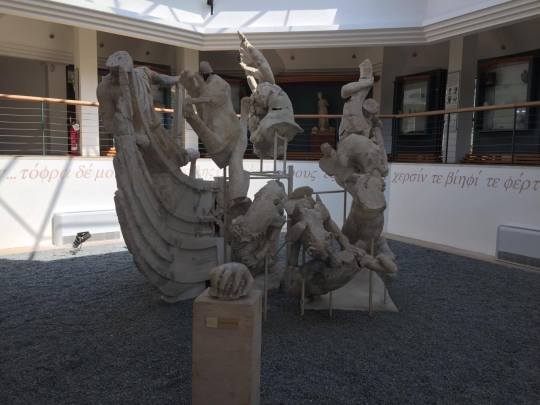
This is B, from that little drawing up there, though it doesn’t really look like all that much. It’s made from the fragments that we have, rather than being a reconstruction, like the Polyphemus scene. It’s from the Odyssey as well, later on in the story, when Odysseus’s ship must pass by the cave of the monster Scylla. Scylla is a sea monster, who has dog heads instead of legs. Yeah. Not dog /legs/ instead of legs, or a dog head instead of a head, but dog heads, multiple, for legs. I’ll let you figure the logistics of that one out, because honestly I have sat through an entire class where twenty classics students, plus our classics PhD professor, tried and failed to understand how exactly that might work. Horrifying? Yes. Very confusing? Also yes. Something that it is very difficult to make a statue of? Also also yes.
This particular scene is of Scylla taking men directly from Odysseus’s ship to eat them. With her human head? With her dog heads? Who knows! Not us! We don’t want to!
We’re missing most of the figure of Scylla, so you’re just going to have to imagine a beautiful woman somewhere in the center of the piece, somehow emerging out of all of those dogs. Also, that hand in the front there is supposed to go on the prow of the ship, we think, but that doesn’t fit the reconstructed image at all unless the artist just threw all of anatomy out of the window when he made the piece, which is not a thing to rule out.
Interestingly, the sculpture is, apparently, made by the same workshop in Rome that crafted the fairly famous sculpture of Laocoon and his sons being eaten by two giant sea snakes. There is a theme in this workshop’s work, can you tell?
Neither of the other two statues were intact enough to take photographs of, just a fragment here and there. However, we know that D, from the drawing, is Odysseus and his bro Diomedes stealing the Palladium of Troy, which was a little statue of Pallas that represented the safety of Troy.
Interesting story about Pallas time! So, while most people associate the name Pallas with an identity of Athena, as in Pallas Athena, that wasn’t the original Pallas. She was a nymph, a friend of Athena’s who trained with her when they were both young (relatively speaking, seeing as Athena was never technically young, she ‘sprung from Zeus’s head fully formed’ which is also a mental image that you really don’t want to think too hard about), until one day Zeus looked down, thought the two of them were fighting instead of training, and distracted Pallas with his shield in the clouds long enough for her to pause, and for Athena to accidentally put a spear through her heart. Athena was devastated, created a likeness of her friend and placed it in Troy so she would not be forgotten, took on the name Pallas Athena, and also declared herself an eternal virgin, by the way, because that is a totally rational reaction to the death of someone who is definitely just a friend. Ehem. Anyway. That statue was stolen by Odysseus because he has no sense of the sacred, so that the Greeks could defeat Troy without their guardian spirit. The Palladium was then moved, some say, to Rome, and placed in the Temple of Vesta in the Roman Forum, to keep Rome safe.
The final statue, A, on the left of the diagram, is a bit of a mystery. It’s two figures, one of whom is dressed in greek armor circa the Trojan War, we know that. The current theories are either that that is Menelaus holding the body of Achilles, or Achilles holding the body of Patroclus. I prefer the second interpretation, honestly, both because I like that story better, but also because according to the Iliad Menelaus didn’t even like Achilles, and I’m pretty sure the myth has Ajax getting all weepy over his body, not Menelaus. I don’t even know where we got the idea of Menelaus from, honestly, because it doesn’t make sense narratively. Also, there are so many statues of Achilles dramatically holding up Patroclus’s body and looking like his world is ending (which it is) that it just seems more plausible that it’s them.
All of these scenes from the Odyssey and the Iliad do actually have a purpose being in the villa of a Roman emperor, by the way, for all that they absolutely also represent the best of Greek legendary history. The villa is built next to the mountain Circeo, which is supposedly the mountain where the sorceress Circe lives, whom Odysseus visits and is enamored by for a full year (anyone who wants you to feel sorry for Odysseus taking ten years to get home clearly has no idea what he was doing in those ten years, honestly), connecting this place in historical memory to the idea of Greek travel and Mediterranean exploration, a thousand years before Rome became a superpower. The statuary is both Tiberius’s way of proving that he is very educated, because to be educated was to be familiar with Greek works, in that time, but also paying homage to local traditions, and retaining the Greek background that all of Rome is simultaneously enormously proud and very ashamed of. The relationship between Greece and Rome is very big sibling/little sibling, where the little sibling becomes enormously successful in life and the older sibling’s accomplishments, impressive though they might be ordinarily, fade to the background in the world’s eyes, but in the eyes of the little sibling they’ll always be. Well. Their older sibling. It’s one part reverence, one part hatred, and a whole lot of uncomfortable familial feelings that few people ever untangle without the help of a very, very good therapist.
After the Villa of Tiberius, we stopped in the unbelievably adorable little town of Sperlonga for lunch. I cannot overemphasize how beautiful this place is. Entirely made of tiny little streets that don’t allow cars? Check. Built of that beautiful white stone that glows in the ever-present sun and makes you feel like you’re wandering through a castle in the sky? Check. Flowers spilling out of every window box, and overhanging trees and vines providing both riotous color amidst the gleaming white buildings and much needed shade? Check. Absolutely breathtaking view of the ocean from the cliffs that it is perched on? Check. 10/10, would go back just to gape at the sheer gorgeousness of the place.
Following lunch, we got back in the bus and drove until we hit Naples, and the Archeological Museum therein.
I typically don’t…. Well, it’s not that I don’t like art museums, I appreciate them in a general sense as cultural conservation, and in certain moods I enjoy walking through them. I just tend to get distracted when looking at something purely visual for too long. It’s why I also do other things while watching TV and movies. So I go through art museums pretty quickly, and as long as I’ve glanced at everything, I feel like I’ve successfully taken everything in. It’s probably why I am the worst person to go to an art museum with, just in general.
(Books, by the way, in no way count as purely visual objects, and I can happily read a book for hours without getting distracted, but that’s reading, not looking.)
However. If there were ever a museum that I could lose a day in, it’s this one.
We covered quite a bit of material, mostly on hyper specific things (-and this is the scrollwork from the top of one of the columns on one of the temples on the Capitoline hill, note the beginnings of Ionian influence in the for the most part standard Doric structure-) that I feel like would not be particularly interesting to you, and in fact are not particularly interesting to me, mostly because that particular lecture tended to be geared towards the art history class, and not my Roman history class, but there were some great pieces of statuary that I want to note.
First, there were the simply exquisite pieces from Rome’s south east bath complex.
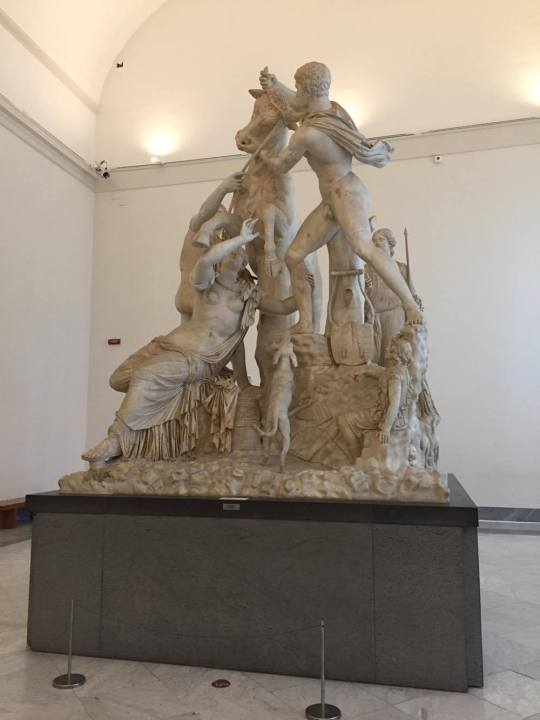
This is a multi-figure piece done in a similar style as the Scylla and the Laocoon pieces I’ve mentioned before, depicting the story of Dirce, a woman who insulted another woman named Antiope, who just happened to have two sons Amphion and Zethis, who got upset at the insult and, as you can see, behaved in that totally rational and calm way that all Greeks and Romans are known for, and punished Dirce by tying her to a raging bull in order to be trampled along the streets of Rome. Fun times.
This sculpture would have been featured at one end of the bath complex, and at the other would have stood a statue of Hercules. We saw that statue, significantly larger than lifelike, as well, though I neglected to take a picture of it. The statue is of a single figure this time, and is called Hercules at Rest, because he’s just kinda standing there, leaning on his club. He looks kinda tired. Me too, buddy, me too.
The statue is significant particularly because it represents a shift in focus in the Greek and Roman art world, from Classical to Hellenistic. In classical style, heroes and gods are typically depicted doing heroic things. Hellenism focuses more on the humanity of heroes and gods, and tends to show them doing rather uniquely human things, like leaning on their clubs to catch a break because just because you can carry the world on your back doesn’t mean you should, Hercules.
Another feature of hellenistic design, and one that makes this my favorite era of ancient art, is that the sculptures take great delight in hiding things in their designs, so that one has to observe the entire piece to get a full understanding of the story being told here. In the case of the Hercules statue, my professor instructed us to walk around to the back of the statue to “see what you observe.”
As the statue was both very large and also not wearing pants, we were all…. mildly alarmed at his suggestion, to say the least. However, we are also sheep, so we dutifully trundled around to the back of the statue to look.
Behind his back, Hercules is holding something. Three round somethings that, back when the statue was painted in its full glory, would have been done in gold.
The presence of the three golden apples, hidden so casually in the statue’s slumped over posture, gives this Hercules at Rest a definitive place in the timeline of the myth of Hercules, and also explains the need for the rest in the first place. Hellenism is about humanizing heroes, sure, but they’re still heroes, and the artist knows that. Even heroes get tired, but heroes get tired from doing things like holding the literal weight of the world on their backs and stealing impossible, Trojan-war-starting prizes from dragons in the gardens of goddesses.
In summary, a good statue.
My least favorite statue, by the way, was this one:

I do not like when the statues have eyes. I just don’t. Why would you do that. She’s going to come alive and murder everyone in this museum. You’re going to have that on your conscience, unnamed dude who thought that five of these were good decoration for his entryway.
(Unnamed dude was actually pretty cool, he owned the House of the Papyri, a villa that was discovered and named for the number of papyri preserved in its library. The statue is one of the Danaids, who were fifty daughters of the king of Danaus, who married his daughters all off in one fell swoop to a fellow king named Aegyptus who happened to have fifty sons. Due to unclear circumstances, the fifty daughters all killed their husbands, all on their wedding night. Except for one, who was clearly just a coward or something. Anyway, there were statues of all fifty of the daughters in Augustus’s temple on the Palatine, and this unnamed homeowner decided to copy his emperor’s super creepy taste in artwork. He was actually probably fairly close to Augustus, at least as much as anyone was, because in his library he had a book dedicated by Virgil himself, and everyone knows that Virgil was Augustus’s bestie. As much as anyone was.)
There was more, so much more, in the museum of Naples but frankly this post is already over four thousand words and I am fairly sure that no one cares about my unhealthily strong opinions about the styling of various Roman emperor busts, so I think I’ll take my leave here.
We left Naples and headed to a hotel in Paestum, called Poseidonia, which was very lovely apart from having a super weird bathroom set up. I may have flooded the bathroom. Just a little bit. There’s just no wall? There’s a little square of tile, with a lip, theoretically to prevent the water from going anywhere, but then the shower head points out into open space and all that the lip on the floor does is block whatever water the shower sprays around the bathroom from getting back tot he drain and long story short I flooded the bathroom a little bit.
But then the hotel was thoughtful enough to provide me with a really delicious gluten free dinner and so all is forgiven really.
#travels#rome#museum#I have forgotten what other tags I might need to use here#I suppose I can add them in later#also I was informed that people wanted to read my blog and perhaps even missed reeading it so no one is allowed to complain about the fact#that it's entirely too long and mostly about Roman art that's just how my life goes okay
1 note
·
View note